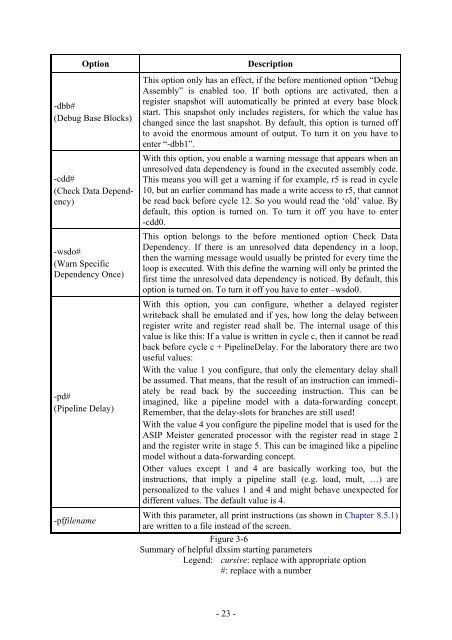Script for Laboratory: Designing embedded ASIPs - CES
Script for Laboratory: Designing embedded ASIPs - CES
Script for Laboratory: Designing embedded ASIPs - CES
Create successful ePaper yourself
Turn your PDF publications into a flip-book with our unique Google optimized e-Paper software.
Option Description<br />
-dbb#<br />
(Debug Base Blocks)<br />
-cdd#<br />
(Check Data Dependency)<br />
-wsdo#<br />
(Warn Specific<br />
Dependency Once)<br />
-pd#<br />
(Pipeline Delay)<br />
-pffilename<br />
This option only has an effect, if the be<strong>for</strong>e mentioned option “Debug<br />
Assembly” is enabled too. If both options are activated, then a<br />
register snapshot will automatically be printed at every base block<br />
start. This snapshot only includes registers, <strong>for</strong> which the value has<br />
changed since the last snapshot. By default, this option is turned off<br />
to avoid the enormous amount of output. To turn it on you have to<br />
enter “-dbb1”.<br />
With this option, you enable a warning message that appears when an<br />
unresolved data dependency is found in the executed assembly code.<br />
This means you will get a warning if <strong>for</strong> example, r5 is read in cycle<br />
10, but an earlier command has made a write access to r5, that cannot<br />
be read back be<strong>for</strong>e cycle 12. So you would read the ‘old’ value. By<br />
default, this option is turned on. To turn it off you have to enter<br />
-cdd0.<br />
This option belongs to the be<strong>for</strong>e mentioned option Check Data<br />
Dependency. If there is an unresolved data dependency in a loop,<br />
then the warning message would usually be printed <strong>for</strong> every time the<br />
loop is executed. With this define the warning will only be printed the<br />
first time the unresolved data dependency is noticed. By default, this<br />
option is turned on. To turn it off you have to enter –wsdo0.<br />
With this option, you can configure, whether a delayed register<br />
writeback shall be emulated and if yes, how long the delay between<br />
register write and register read shall be. The internal usage of this<br />
value is like this: If a value is written in cycle c, then it cannot be read<br />
back be<strong>for</strong>e cycle c + PipelineDelay. For the laboratory there are two<br />
useful values:<br />
With the value 1 you configure, that only the elementary delay shall<br />
be assumed. That means, that the result of an instruction can immediately<br />
be read back by the succeeding instruction. This can be<br />
imagined, like a pipeline model with a data-<strong>for</strong>warding concept.<br />
Remember, that the delay-slots <strong>for</strong> branches are still used!<br />
With the value 4 you configure the pipeline model that is used <strong>for</strong> the<br />
ASIP Meister generated processor with the register read in stage 2<br />
and the register write in stage 5. This can be imagined like a pipeline<br />
model without a data-<strong>for</strong>warding concept.<br />
Other values except 1 and 4 are basically working too, but the<br />
instructions, that imply a pipeline stall (e.g. load, mult, …) are<br />
personalized to the values 1 and 4 and might behave unexpected <strong>for</strong><br />
different values. The default value is 4.<br />
With this parameter, all print instructions (as shown in Chapter 8.5.1)<br />
are written to a file instead of the screen.<br />
Figure 3-6<br />
Summary of helpful dlxsim starting parameters<br />
Legend: cursive: replace with appropriate option<br />
#: replace with a number<br />
- 23 -
















